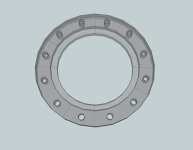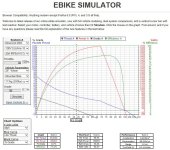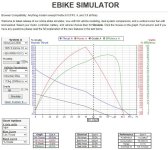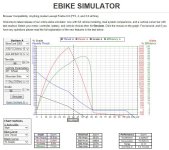molybdenum said:
Life's full of tradeoffs; yes I have hills and traffic lights but I also have lots of long flat stretches with relatively few lights. I am happy with the 4x15 winding we have ordered.
Also, there are other easy ways to increase torque such as feeding the motor more amps and going to a smaller diameter wheel.
Those aren't
other ways. Those are the
only ways to increase torque. It's pure myth that the 5x12 winding has more torque than the 4x15. They have the same amount of copper on each tooth, so they are identical motors. You simply run voltage and current proportionately different and performance will be identical. The 5x12 will have higher inductance, making it an easier load on a controller, but that's only a concern with a 2 turn and maybe a 3 turn winding.
Take the supposedly better hill climbing 5x12 motor run at 100V and 50A peak current. With the same size wheel running the 4x15 to get to the same rpm, torque, efficiency, etc simply run it at 80V and 62.5A peak current (and the same proportionately higher phase current limit). The thicker shorter copper of the speedier wind can handle the proportionately higher current. 5000W peak into each motor with identical results.
If you want to climb hills better, then more torque is needed, and the best way to do that is by decreasing the wheel size.
The real beauty of speed wind motors is due to voltage being our practical limitation. The above example makes the difference clear. Using reasonably priced controllers the 5x12 is maxed out other than to try to stuff more current into it, which it handles less well. Decreasing wheel size is always good, but that decreases speed for the 5x12. To keep the numbers round let's say you were looking at running a wheel with an OD of 25". With the 4x15 you can decrease the wheel size to 20" for a 20% increase in torque, and then increase voltage to 100V to put you back to the same speed. Not only do you get more torque to be able to climb a steeper hill, but you also have more power 6250W peak input, so you can climb hills faster. The decreased load of the motor sees with the lower gearing, means the motor will run more efficiently, at reduced stress, and the higher rpm means better cooling too. Better cooling and better efficiency means a cooler motor, and that too adds a bit more efficiency as well.
Wait it still gets better. Let's say the guy running the 4x15 in the 20" wheel knows that his buddy with the 5x12 wind in a 25" wheel isn't having heat issues running his at 5kw peak input, and they run the same total load with similar riding, so he's willing to run his 4x15 at the same stress levels. That means he can boost current even higher, probably to 70 or 80A without issue. So now he's running the same weight and price motor at 7-8kw, and putting his system under no more stress than the poor guy who ordered the 5x12 motor and can only run at 5kw. Who do you think will have the bigger EV grin when they ride together?

Sure it's a little harder to make that 20" wheel look as good on the bike, but with hubmotors those who value looks over performance get stuck with the lower performance resulting.
How do you guys think I've been running my cargo bike for almost 6 years with a 60mph top speed on 74V nominal with my wide body load in a mountainous country? No, it's not because it has a bigger motor. It's got a stator and magnets that are identical to an Xlyte H40, but with a 2 turn wind and a 14" moto wheel that ends up just under 20" OD.
Note that the above discussion doesn't mention iron losses, which increase with rpm. They're pretty minor though up to about 1krpm with common high slot count motors. To verify how small it is, take your motor before it gets laced and measure the no-load current at different rpms at the high end of the scale. The difference in no-load current X voltage is how much more iron losses you have, and to make the comparison you don't want the wind resistance of wheel and spokes giving you misleading results.
John

Sure it's a little harder to make that 20" wheel look as good on the bike, but with hubmotors those who value looks over performance get stuck with the lower performance resulting.



